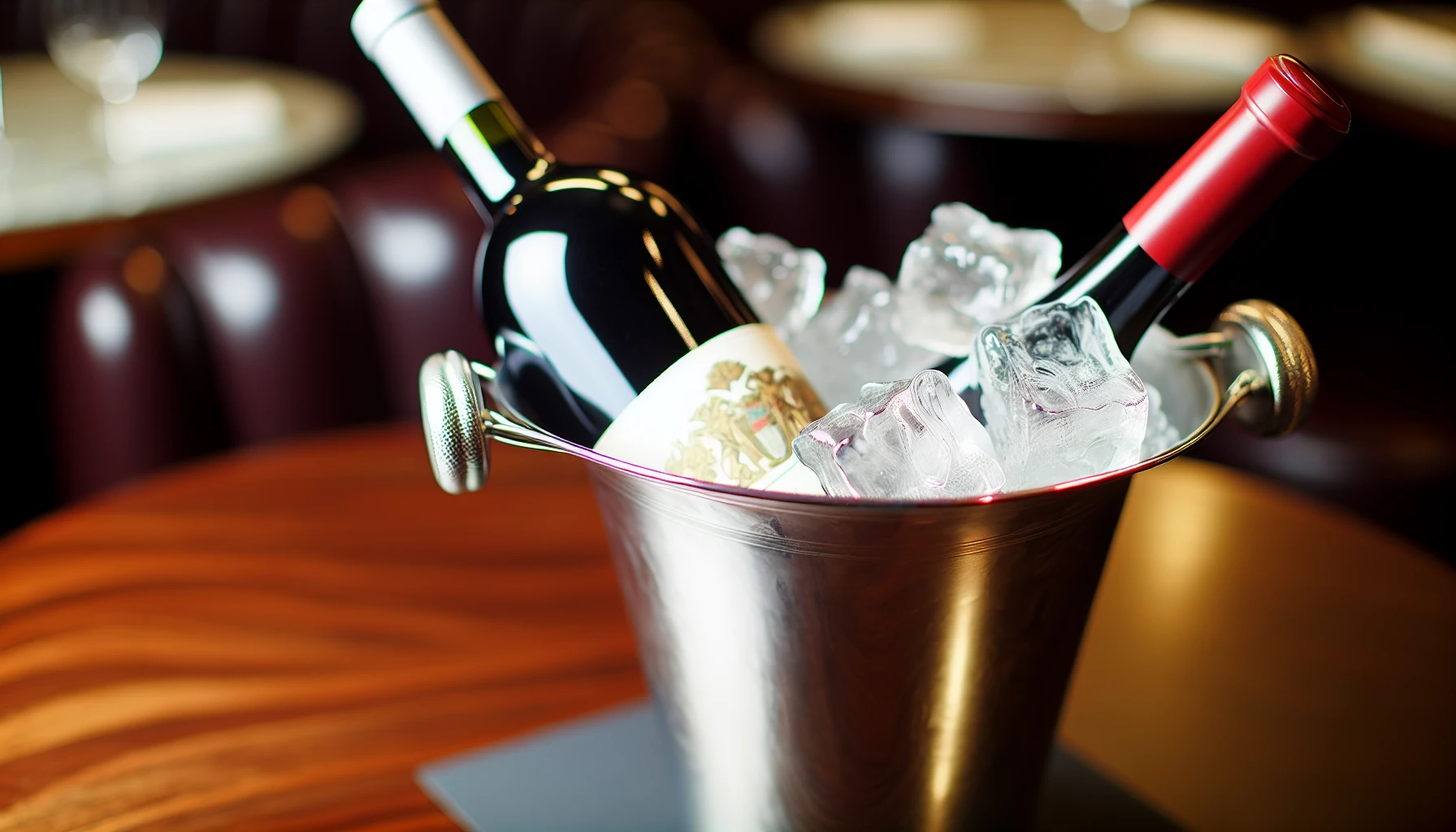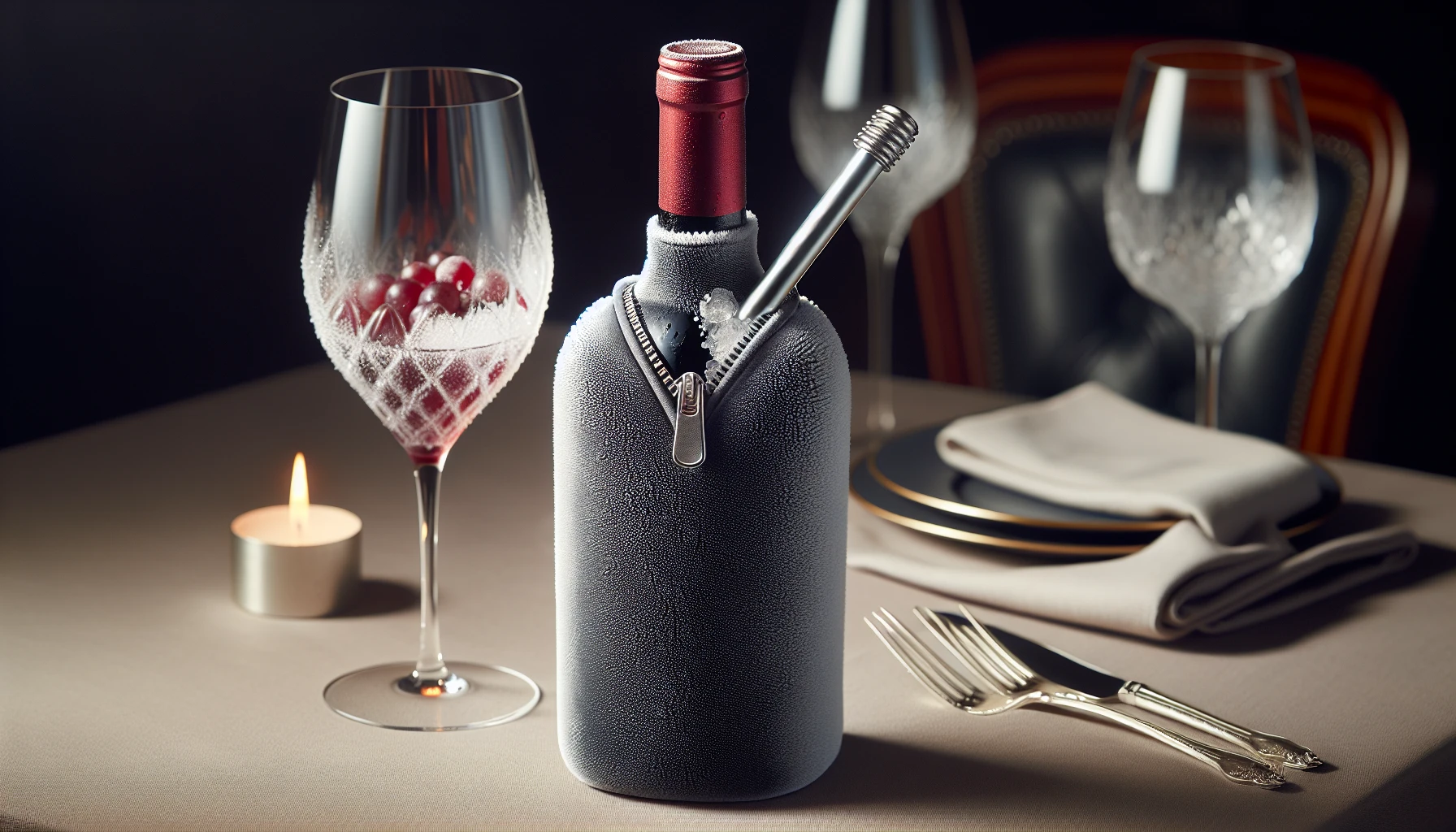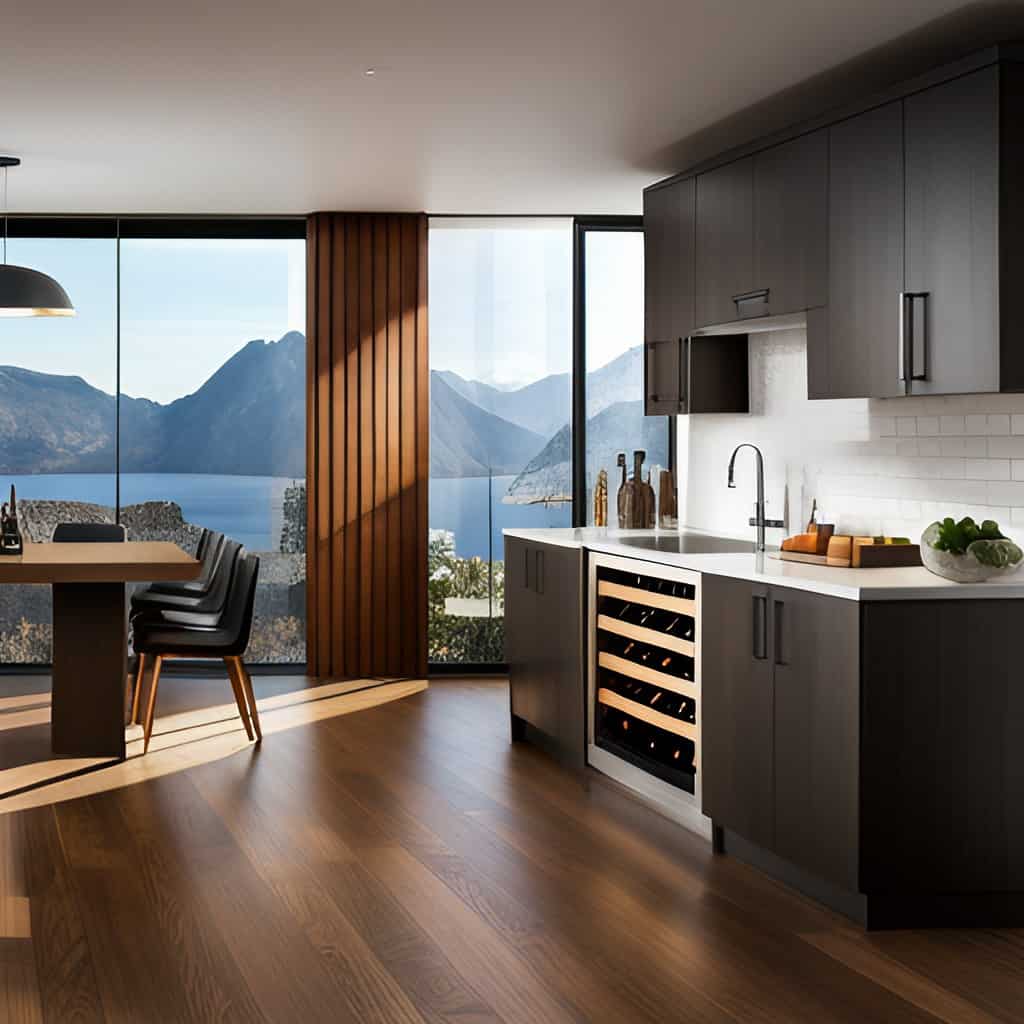Should Red Wine Be Chilled Before Savoring?
The thought might make some traditionalists shudder but don’t dismiss it too quickly. A growing trend among wine enthusiasts and sommeliers suggests that chilling certain red wines can enhance their flavors and structure. So, should red wine be chilled? Are you ready to break the mold and elevate your wine experience? Let’s dive into the fascinating world of chilling red wines and explore the factors that will help you decide.
Follow this link to learn about my recommendations on the best wine fridges.
Key Takeaways
- Chilling red wine can enhance its flavor depending on the variety, personal preference, and occasion.
- Expert advice should be followed when determining the optimal temperature for red wines to ensure an improved tasting experience.
- Chilled red wines can be paired with various dishes based on the body and temperature of the wine.
Should Red Wine be chilled?

Contrary to popular belief, chilling red wine is not a faux pas. Some red wines benefit from being chilled, as they can enhance their flavors and structure. The optimum temperature range for chilling red wine in a wine fridge is 55 to 60 degrees Fahrenheit.
However, choosing to chill red wine depends on various factors, such as variety, personal preference, and occasion. We will examine these factors more closely to ascertain whether chilling your red wine is beneficial.
Factors Affecting Red Wine Temperature
Several factors, including the type of wine, climatic conditions, individual preference, age, body, and sugar content, influence the ideal serving temperature for red wine. Different varieties of red wine have their own recommended serving temperatures, with lighter-bodied wines like Pinot Noir and Gamay benefiting from cooler temperatures. In contrast, fuller-bodied wines are best enjoyed slightly warmer.
Personal preference also plays a significant role in determining the temperature at which red wine is served. Some may prefer slightly cooler or warmer red wine than the recommended range. A balance between personal preference and the wine’s characteristics is vital. Serving red wine too cold can lessen its flavors and aromas, and serving it too warm can lead to a strong alcoholic taste.
The occasion also factors into the optimal serving temperature of red wine, wherein informal gatherings or warm summer days may necessitate a more refreshing, chilled red wine or a glass of rosé wine.
Wine Variety
Different red wines have varying ideal serving temperatures. Lighter-bodied red wines, such as Pinot Noir, Gamay, Lambrusco, and Beaujolais (produced from Gamay grapes) are known to be improved by chilling. In contrast, fuller-bodied, high-tannin, and high-alcohol red wines should not be cooled. Lighter-bodied red wines should be served at a temperature of 55-61°F (13-16°C) to retain their subtle aromas and acidity, while fuller-bodied red wines are best enjoyed at a temperature of 55-65°F (12-18°C) to maximize their flavors.
Remember that the ideal temperature for chilling red wine varies based on the variety. For example, Schiava, Frappato, and certain Cabernet Francs are typically enjoyed as a chilled drink. Serving red wine at the right temperature can enhance the overall experience, as wine served at the right temperature can prevent it from having an unpleasant taste that is overly alcoholic and a burning sensation upon consumption.
Personal Preference
The decision to chill red wine rests heavily on personal preference. The optimal temperature for serving red wine is 55-65 degrees Fahrenheit. Some individuals may prefer their red wine slightly cooler, while others may favor it at room temperature. Each person has distinctive taste buds and preferences, which can shape their perception of the flavors and characteristics of red wine.
Pairing red wine with food can also influence the enjoyment of the wine based on personal taste preferences. Certain flavor combinations can augment the overall experience and make the wine more palatable. Ultimately, the decision to chill red wine is subjective and based on personal preference and the characteristics of the particular wine being served.
Occasion
The occasion might significantly influence the decision to chill red wine. Chilled red wine is most appropriate for summer gatherings, outdoor parties, and warm-weather events. In these situations, lighter-bodied red wines like Pinot Noir, Zinfandel, Cabernet Sauvignon, and Cabernet Franc are recommended to be served chilled. On the other hand, for a formal dinner or a special occasion, it is generally suggested to serve red wine at room temperature to savor its flavors and aromas fully.
The formality of an occasion also dictates the serving temperature of red wine. In casual settings, most red wines are slightly chilled and served around 15-18°C or 58- 64°F.
However, serving red wines at room temperature is advised for more formal events. Therefore, the nature and ambiance of the event can significantly influence the decision to serve chilled or room-temperature red wine.
Expert Tips for Chilling Red Wine

Experts suggest using the following methods to attain the desired temperature for red wine:
- Ice bucket
- Refrigerator
- Wine cooler sleeve
- Wine chiller stick
Chilling red wines to a cooler temperature can avoid an unpleasant wine taste that is overly alcoholic and a burning sensation upon consumption. To properly chill wine, especially red wines, follow the guidelines for achieving the perfect temperature.
Ms. Fleming, a wine expert, advises storing wines at a slightly lower temperature than the recommended serving temperature, as the wine will be warmed slightly when poured into the glass. This guarantees that the wine, served at the appropriate temperature, improves the overall experience. Considering expert advice and testing different chilling methods to find your red wine’s ideal temperature is advised.
Ice Bucket Method
The ice bucket method involves:
- Placing the wine bottle in a bucket filled with ice and water to chill the wine quickly.
- This method typically takes 10-20 minutes for red wine to attain its optimal temperature.
- Crushed ice is preferable, as it has a larger surface area, thus facilitating a quicker cooling of the wine.
The science behind using an ice bucket to chill red wine is as follows:
- The ice and water in the bucket generate a cold environment.
- The cold environment cools down the wine quickly.
- The contact between the ice water and the wine bottle facilitates heat transfer from the wine to the surrounding environment.
- This results in a more expeditious chilling process.
Fridge Method

The fridge method involves:
- Place the wine bottle in the refrigerator appropriately, depending on the preferred serving temperature.
- The optimal refrigerator temperature for chilling red wine utilizing the fridge method is approximately 55 degrees Fahrenheit.
- It generally takes about one hour of refrigeration to attain the optimal serving temperature for red wine.
Using the fridge to chill red wine can alter the wine’s taste. Cooling red wine can obscure imperfections in an inferior bottle and obscure exceptional characteristics in a superior one. However, frequent chilling and warming can affect the quality of the wine. Overchilling the wine should be avoided as it can mask its flavors.
Wine Cooler Sleeve and Chiller Stick
Wine cooler sleeves and chiller sticks can maintain the wine’s temperature while serving, ensuring it stays chilled throughout the event. A wine cooler includes a plastic sleeve with cooling gel or a removable cooling element. One must keep the sleeve in the freezer, and when they wrap it around a bottle of red wine, it chills the wine within minutes and maintains its temperature for hours without the necessity of a refrigerator or ice.
To utilize a wine chiller stick to keep red wine at the optimal temperature, one should follow these steps:
- Place the wine chiller stick in the freezer for a few hours or as the manufacturer recommends.
- Retrieve the chilled wine chiller stick from the freezer and insert it into the bottle of red wine.
- Allow the wine chiller stick to cool the wine for a few minutes.
- Remove the wine chiller stick from the bottle.
- Pour the wine into a glass.
- Don’t forget to follow the manufacturer’s instructions for the specific wine chiller stick being used.
Pairing Chilled Red Wines with Food

Pairing chilled red wines with food can elevate the dining experience. Here are some tips to keep in mind:
- Lighter-bodied wines pair well with spicy dishes.
- Fuller-bodied wines are ideal for grilled meats.
- Temperature plays an essential role in the pairing of red wines with food. Serving red wine too cold can bring out its acidity, bitterness, and tannins, while serving it at room temperature may cause it to taste too warm.
Lighter-bodied chilled red wines are known to be complemented by dishes such as beef, duck, avocado, cheese, seafood, salads, and grilled chicken. On the other hand, fuller-bodied chilled reds are often suited to meat dishes such as grilled blue cheeseburgers, breaded cutlets, kibbeh, steaks, and lamb, as well as dishes featuring charred broccoli with egg yolk sauce, kimchi dressing, pine nuts, and fried shallots. In addition to red wines and white wine, sparkling wines can also be a delightful choice for various food pairings.
Key Considerations
Consider the variety, personal preference, occasion, and expert advice when choosing a chilling red wine. Here are some guidelines to consider:
- Lighter-bodied red wines like Pinot Noir and Gamay are best served slightly cooler.
- Fuller-bodied red wines like Cabernet Sauvignon and Merlot are served at room temperature.
- Personal preference plays a significant role; some may prefer slightly cooler or warmer red wine than the recommended range.
Experimenting with different chilling methods and temperatures can help you find the ideal serving temperature for your red wine. The decision to chill red wine is subjective, relying on personal preference and the characteristics of the specific wine being served. Don’t hesitate to experiment and find new ways to enjoy your favorite red wines.
Summary
Chilling red wine is not a faux pas but a trend gaining popularity among wine enthusiasts and sommeliers alike. The ideal serving temperature for red wine depends on various factors, including the wine variety, personal preference, and occasion. Pairing chilled red wines with food can enhance the overall dining experience, with lighter-bodied wines working well with spicy dishes and fuller-bodied wines complementing grilled meats.
So, the next time you’re about to enjoy a glass of red wine, consider chilling it to see if it enhances the flavors and structure. You may discover a new way to savor your favorite reds, making your wine experience more delightful and memorable.
Frequently Asked Questions
Do you chill red wine?
Yes, red wine should be chilled. Wine experts recommend serving it at a temperature range of 55°F–65°F to enjoy the optimal flavor profile and avoid overbearing alcoholic notes.
Should pinot noir be chilled?
Pinot noir should be served slightly chilled at about 55°F and not need to be decanted. Drink this delicate, acidic, lower-tannin red wine from a large, bell-shaped glass for the best experience.
Should wine be chilled?
For optimal flavor, light-bodied and sweet wines should be chilled between 45°F and 50°F. Fuller-bodied wines taste better and are slightly warmer at 57-70°F. Ultimately, it’s up to personal preference, but following these guidelines will allow you to experience the best flavors of your favorite wines.
How can I chill red wine quickly?
It takes 10-20 minutes. Place the bottle in a bucket of ice and water to get it to the desired temperature.
What types of food pair well with wine?
Wine can be paired with various dishes, such as beef, duck, avocado, cheese, seafood, salads, grilled chicken for lighter-bodied wines, and grilled meats for fuller-bodied varieties.

